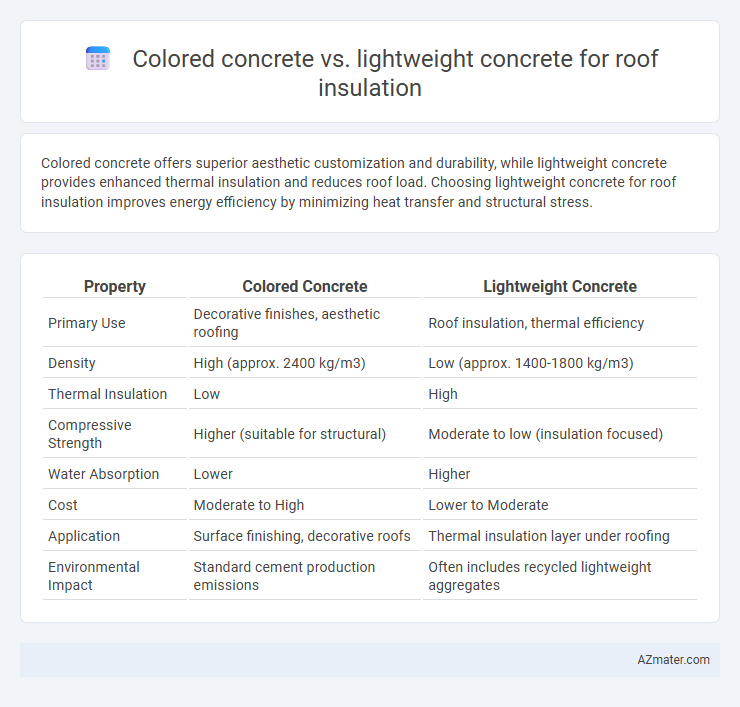Colored concrete offers superior aesthetic customization and durability, while lightweight concrete provides enhanced thermal insulation and reduces roof load. Choosing lightweight concrete for roof insulation improves energy efficiency by minimizing heat transfer and structural stress.
Table of Comparison
| Property | Colored Concrete | Lightweight Concrete |
|---|---|---|
| Primary Use | Decorative finishes, aesthetic roofing | Roof insulation, thermal efficiency |
| Density | High (approx. 2400 kg/m3) | Low (approx. 1400-1800 kg/m3) |
| Thermal Insulation | Low | High |
| Compressive Strength | Higher (suitable for structural) | Moderate to low (insulation focused) |
| Water Absorption | Lower | Higher |
| Cost | Moderate to High | Lower to Moderate |
| Application | Surface finishing, decorative roofs | Thermal insulation layer under roofing |
| Environmental Impact | Standard cement production emissions | Often includes recycled lightweight aggregates |
Introduction to Roof Insulation Materials
Colored concrete enhances roof aesthetics and durability while providing moderate thermal mass, making it suitable for energy-efficient roofing systems. Lightweight concrete offers superior insulation properties due to its low density and high air content, reducing heat transfer and improving thermal comfort. Comparing these materials highlights the balance between structural performance and insulation effectiveness in roof construction.
What is Colored Concrete?
Colored concrete is a type of concrete that incorporates pigments during the mixing process to achieve various hues and shades, enhancing aesthetic appeal without compromising strength. It is commonly used in architectural applications, including roof surfaces, where visual design is important alongside functional properties like thermal mass. Unlike lightweight concrete, colored concrete tends to have higher density and thermal conductivity, which affects its insulation performance on roofs.
What is Lightweight Concrete?
Lightweight concrete is a specialized type of concrete incorporating lightweight aggregates such as expanded clay, shale, or pumice, which significantly reduce its density compared to traditional concrete. This lower density enhances thermal insulation properties, making it an ideal material for roof insulation by minimizing heat transfer and improving energy efficiency. Colored concrete, while aesthetically versatile, typically lacks the insulating benefits inherent to lightweight concrete due to its denser composition.
Thermal Performance Comparison
Colored concrete typically has higher thermal mass, absorbing and slowly releasing heat, which can help regulate indoor temperatures but may retain heat longer in warm climates. Lightweight concrete contains air-filled pores or aggregates that provide superior insulation due to lower thermal conductivity, reducing heat transfer through the roof and improving energy efficiency. For roof insulation, lightweight concrete generally offers better thermal performance by minimizing heat gain and loss, enhancing overall thermal comfort and reducing cooling and heating loads.
Weight and Structural Impact
Colored concrete typically has a higher density, ranging from 2300 to 2500 kg/m3, resulting in greater weight and increased load on roof structures compared to lightweight concrete, which weighs between 1200 and 1800 kg/m3. The reduced weight of lightweight concrete minimizes structural impact, making it ideal for roof insulation where load reduction is crucial for maintaining structural integrity. Employing lightweight concrete enhances energy efficiency without compromising durability, offering significant advantages over colored concrete in terms of weight-sensitive roofing applications.
Aesthetic and Design Flexibility
Colored concrete offers superior aesthetic appeal with customizable hues and patterns that enhance roof design, providing architects with extensive creative freedom. Lightweight concrete enables innovative structural designs due to its reduced weight, improving installation ease and allowing for more complex roof geometries. Combining color integration with lightweight properties in concrete materials delivers a balance between visual appeal and functional design flexibility for advanced roof insulation solutions.
Durability and Longevity
Colored concrete provides superior durability for roof insulation due to its dense composition and resistance to weathering, UV rays, and chemical exposure. Lightweight concrete offers excellent thermal insulation and reduces structural load but may have lower compressive strength and be more susceptible to cracking over time. For long-term longevity, colored concrete typically outperforms lightweight concrete because it maintains structural integrity under harsh environmental conditions.
Installation Process and Cost
Colored concrete for roof insulation involves a straightforward installation process similar to traditional concrete, requiring minimal additional labor, which keeps costs moderate. Lightweight concrete, with its lower density, is easier to handle and install, reducing labor time and expenses, despite slightly higher material costs due to specialized aggregates. Overall, lightweight concrete often proves more cost-effective in roofing insulation projects when considering both installation efficiency and performance benefits.
Environmental Considerations
Colored concrete for roof insulation offers enhanced solar reflectance, reducing urban heat island effects and energy consumption, while lightweight concrete provides superior thermal insulation through air voids, lowering heating and cooling demands. Lightweight concrete typically incorporates recycled materials such as fly ash or expanded shale, contributing to reduced carbon footprint and resource conservation compared to traditional aggregates used in colored concrete. Both materials support sustainable construction, but lightweight concrete's lower density results in less structural load, potentially decreasing overall material use and embodied energy in roofing systems.
Best Applications and Recommendations
Colored concrete offers superior aesthetic appeal and durability, making it ideal for exposed roof surfaces where visual impact matters. Lightweight concrete excels in thermal insulation and reduces structural load, perfect for flat or low-slope roofs requiring energy efficiency and weight reduction. For optimal roof insulation, use colored concrete in decorative areas and lightweight concrete in sections needing enhanced insulation and load management.

Infographic: Colored concrete vs Lightweight concrete for Roof insulation
 azmater.com
azmater.com